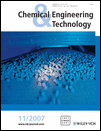Neural Network Based Control of the Acrylonitrile Polymerization Process
Abstract
Acrylic fiber is commercially produced by free radical polymerization, initiated by a redox system. Industrial production of polyacrylonitrile is a variant of aqueous dispersion polymerization, which takes place in a homogenous phase under isothermal conditions with perfect mixing. The fact that the kinetics are a lot more complicated than those of ordinary polymerization systems makes it difficult to control the molecular weight. On the other hand, abundant data is being gathered in industrial polymerization systems, and this information makes the neural network based controllers a good candidate for managing such a difficult control problem. Multilayer neural networks have been applied successfully in the identification and control of dynamic systems. In this work, the neural network based control of continuous acrylonitrile (ACN) polymerization is studied, based on a previously developed new rigorous dynamic model for the polymerization of acrylonitrile. Two typical neural network controllers are investigated, i.e., model predictive control and NARMA-L2 (Nonlinear Auto Regressive Moving Average) control. These controllers are representative of the variety of common ways in which multilayer networks are used in control systems. The results present a comparison of the two common neural network controllers, and indicate that the model predictive controller requires a larger computational time.




